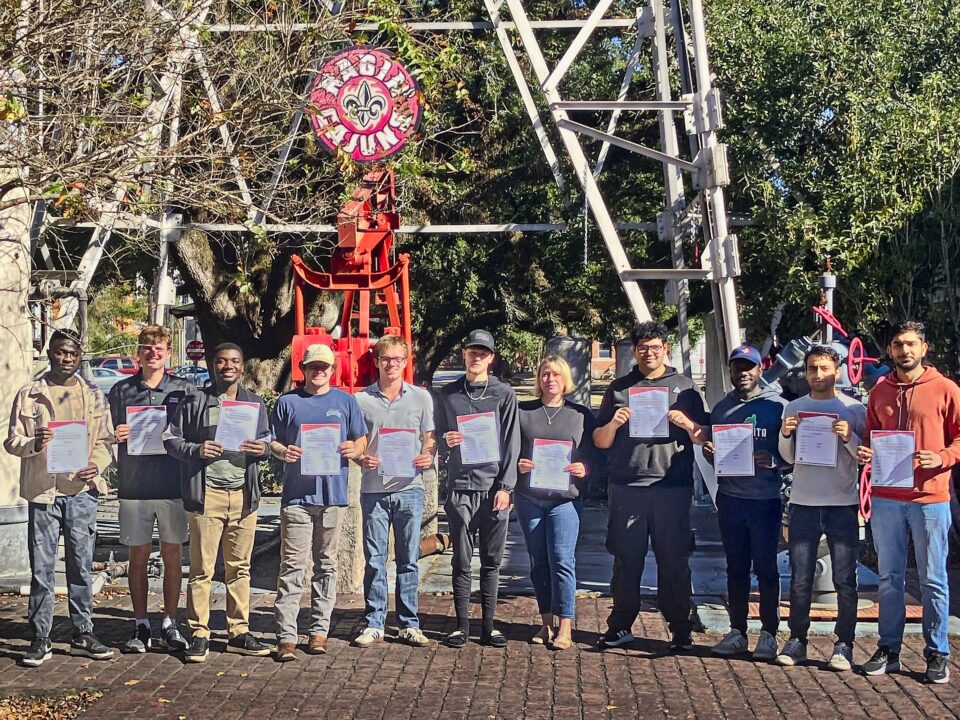November Tech Forum Agenda:
08.30-08.35 Welcome – Dennis Moore, Chairman, and introduction to event – Michael Edwards, Andrew Barry and Robin Macmillan, DEC Board members
08.35-08.50 Michael Matthews, Data Gumbo, will report on how the industry is addressing the following:
- What are the definitions of Scopes 1, 2 and 3 emissions?
- What are the challenges associated with the reporting of each?
- What standards are established?
- How can we establish a baseline?
- How can we establish goals?
- How can we measure progress?
08.50-09.15 Well Engineering for Dedicated and Reliable CO2 Sequestration: Sarah Leung, Carbon Storage Engineer, CCUS R&D, U.S. Department of Energy
This presentation will provide an overview of the growing geologic carbon storage and transport industry in the United States, highlighting over 20 years of DOE R&D in CO2 sequestration. Well engineering is a pivotal skill set needed to deploy widespread geologic carbon storage. There will be a brief overview of a permitted EPA Class VI well to discuss well design and construction requirements. As the conversation focuses on reversing the flow of carbon, this discussion will also bring attention to opportunities that exist in repurposing oil & gas wells to dedicated and reliable carbon storage.
09.15-09.40 Exploring Technologies to Reduce Harmful Emissions in Drilling and Completion Operations: Anton Pitchko, Oxy
Environmental, Social, and Governance (ESG) matters are now a part of how companies conduct their drilling and completion operations. Operators are actively searching for ways to reduce their greenhouse gas emissions and find opportunities to utilize carbon-driven resources more efficiently. Because of the industry push to continually improve environmental performance, there have been many technology developments for rig power management and reduction of carbon intensity. In this forum, some of these technologies and approaches will be discussed.
09.40-10.05 The Path to Environmental Sustainability for Land Drilling Rigs: Ashley Fernandes, Precision Drilling
As our industry moves into a transformation phase for GHG inventories and emissions reductions, rig contractors are acting early to plan for and improve environmental sustainability. At the helm of GHG inventories are quantifying baseline emissions for power generation through the period of rig operations. Once baselines are computed, plans to transition to hybrid and alternative energy power sources are put in place to further improve energy efficiency, reduce fuel consumption and resulting GHG emissions. This presentation will provide an in-depth look at high spec land rigs quantifying the various power sources and the impact of fuel consumption on emissions. It will also focus on new technologies involving battery energy storage systems and hybrid engine management systems. Also discussed are the other areas for GHG reduction including rig lighting, automation and rig moves. Finally we will present our methodology for reporting GHG emissions and other measurements in real time with an auditable trace to secure goals and targets set by contractors and operators.
10.05-10.30 The Pathway Towards a Sustainable Transition: Assaad Mohanna, NOV
Whether it’s in renewables, low-carbon solutions or in oilfield emissions, our industry can play a critical role in advancing and contributing to the energy transition. At NOV we have taken a unique approach at how to be part of this long journey, and how can we be a leading player in these emerging spaces. Using available technology and an innovation mindset, we have repositioned and repurposed our capabilities to solve challenges and bottle necks, making the energy transition more accessible to the world.
While global policy is still shaping up, and while energy companies are exploring their options, the energy transition is moving at a great pace. In this presentation we will address some of the capabilities and technology that we are deploying to make energy companies differentiate themselves in renewables, low carbon solutions and fuel efficiency, driving towards a more economically balanced opportunity, a safer operation, and quicker to market.
10.30-10.40 BREAK
10.40-11.05 Improved ESG Impacts Through Drilling Technology and Digital Capabilities: Roxana Nielsen, Halliburton
The challenges of the energy transition allow Halliburton to continue to do what we do best: innovate, collaborate and execute to drive efficiencies and affect change, including lowering the emissions profile of our technologies. These opportunities for innovation and growth improve our overall sustainability while helping our customers reduce emissions and decarbonize their production base. This presentation will highlight some of our drilling and digital technologies that are making a real ESG impact.
11.05-11.30 Hybrid Rigs Leverage Battery Energy Storage to Deliver Higher Efficiency, Lower Emissions: Tony DeSalvo, Ensign Energy Services, and Sean Halloran, NexESS Analytics
Over the past decade, drilling contractors have steadily increased performance and reliability, delivering wellbores safely and consistently while lowering the cost. Power generation at the wellsite supports all aspects of drilling. Fuel costs can be 10%-20% of the rig’s day-rate. In 2014, Ensign Energy Services drilled their first commercial wells with a hybrid rig that paired a Battery Energy Storage System (BESS) with natural gas gensets to deliver both fuel savings and emissions reduction, allowing the operator to increase their campaign in an emissions-limited area. From that beginning, Ensign has continued to pioneer the usage of energy storage with both natural gas and diesel gensets as well as highline (grid-tied) powered rigs, using both super-capacitors and lithium-ion batteries.
NexESS Analytics has worked with Ensign to model the value proposition of deploying a BESS to their modern fleet of AC super-spec rigs, going beyond fuel savings and emissions reduction to show the many ways energy storage makes sense in today’s ESG-conscious yet capital constrained market. Comparing this model with the latest real-world data from wells drilled in multiple basins using hybrid-powered rigs has enabled Ensign to fine tune their approach to energy storage on drilling rigs. We will report on this 7 year journey, detailing what has worked, what challenges we faced and what we are doing to continue to responsibly connect the world to energy resources.
11.30-12.00 GROUP Q&A: Our speakers will all come together for a joint interactive Q&A session with the audience.
12.00 Adjournment
For more information, contact Linda Hsieh, linda.hsieh@iadc.org, +1-713-292-1945, ext 219.




